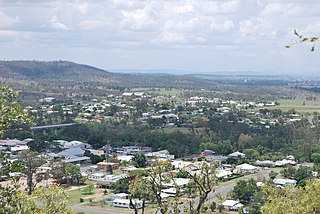
Gayndah is a town and locality in the North Burnett Region, Queensland, Australia. In the 2016 census, Gayndah had a population of 1,981 people. It is the administrative centre for the North Burnett Region.

Mount Perry is a rural town and locality in the North Burnett Region, Queensland, Australia. In the 2016 census, the locality of Mount Perry had a population of 538 people.

Boolboonda Tunnel is an abandoned heritage-listed railway tunnel at Tunnel Road, Boolboonda, Bundaberg Region, Queensland, Australia. The tunnel is 192 metres (630 ft) in length making it the longest unsupported man-made tunnel in Queensland. Its construction represented an important engineering feat for rail transport in Queensland. It was built from 1881 to 1884 by O'Rourke & McSharry. It is also known as Boolboonda Railway Tunnel and SEQ-6Q 1. It was added to the Queensland Heritage Register on 24 September 1999.

The Mount Perry Branch Railway is a closed railway line in Central Queensland, Australia. In 1869 copper was discovered at Mount Perry and the township grew rapidly. A railway to the coast was essential to provide cheap transport and make the mining of low percentage ore viable. Maryborough and Bundaberg vied for the opportunity to be the terminus and the latter city was successful.
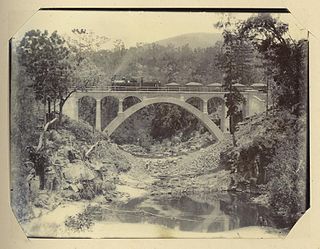
The Mungar Junction to Monto railway line is a 267-kilometre (166 mi) railway in Queensland, Australia. Progressively opened in eleven stages between 1889 and 1928 the line branched from the North Coast line at Mungar Junction a short distance west of Maryborough and followed a westerly route towards Biggenden and Gayndah before turning north via Mundubbera and Eidsvold to Monto. It is also known as the Gayndah Monto Branch Railway.

St Mary's Church is a heritage-listed Roman Catholic church at 271–275 Adelaide Street, Maryborough, Fraser Coast Region, Queensland, Australia, on land donated to the Church by Maryborough pioneer James Cleary. It was initially designed by Charles Tiffin with later additions and alterations by Francis Drummond Greville Stanley and POE Hawkes. The initial construction was from 1869 to 1872 by G Smith and J Thomas. It was added to the Queensland Heritage Register on 21 October 1992.
Byrnestown is a rural locality in the North Burnett Region, Queensland, Australia. In the 2016 census, Byrnestown had a population of 34 people.
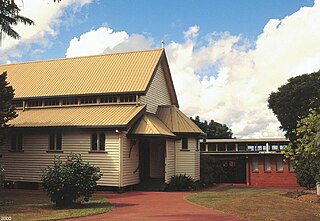
Christ Church is a heritage-listed church at 24 Macrossan Street, Childers, Bundaberg Region, Queensland, Australia. It was designed by John Hingeston Buckeridge and built from 1900 to 1958. It is also known as the Anglican Church. It was added to the Queensland Heritage Register on 28 April 2000.

St Patrick's Church is a heritage-listed Roman Catholic church at Rosewood - Aratula Road, Rosevale, Scenic Rim Region, Queensland, Australia. It was designed by Father Andrew Horan and built from 1888 to 1889. It was added to the Queensland Heritage Register on 11 December 2009.
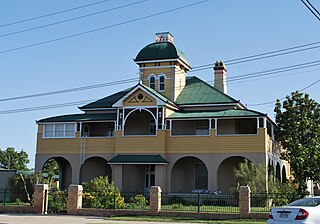
St Mary's Presbytery is a heritage-listed Roman Catholic presbytery of St Mary's Roman Catholic Church at 142 Palmerin Street, Warwick, Southern Downs Region, Queensland, Australia. It was designed by Wallace & Gibson and built from 1885 to 1887 by John McCulloch. It is also known as Father JJ Horan's private residence. It was added to the Queensland Heritage Register on 31 July 2008.

Bundaberg School of Arts is a heritage-listed former school of arts and now community centre at 184 Bourbong Street, Bundaberg Central, Bundaberg, Bundaberg Region, Queensland, Australia. It was designed by Anton Hettrich and built from 1888 to 1889. It was added to the Queensland Heritage Register on 21 October 1992.
Frederic Herbert (Herb) Faircloth (1870–1925) was an architect in Bundaberg, Queensland, Australia. Many of his buildings are now heritage-listed.

Kennedy Bridge is a heritage-listed road bridge on Bourbong Street crossing Bundaberg Creek from Bundaberg Central to Bundaberg East in Bundaberg, Bundaberg Region, Queensland, Australia. It was designed by Alfred Barton Brady and built in 1899. It is also known as Saltwater Creek Road Bridge. It was added to the Queensland Heritage Register on 21 October 1992.

Gin Gin railway station is a heritage-listed railway station at Mulgrave Street, Gin Gin, Bundaberg Region, Queensland, Australia. It was built from 1888 to c. 1928. It is also known as Gin Gin Railway Station, Goods Shed & Refreshment Rooms. It was added to the Queensland Heritage Register on 28 July 2000.

Childers Pharmaceutical Museum is a heritage-listed former pharmacy and now museum at 88-90 Churchill Street, Childers, Bundaberg Region, Queensland, Australia. It was designed by F H Faircloth and built from 1902 to 1909. It is also known as Gaydon's Pharmacy and Tourist Information Centre. It was added to the Queensland Heritage Register on 21 October 1992.
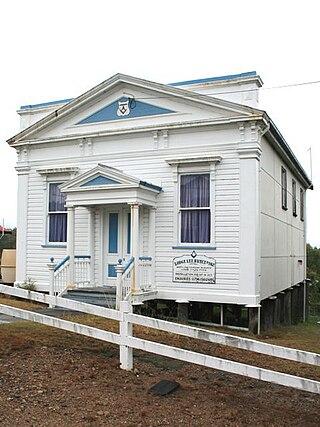
Mount Perry Masonic Lodge is a heritage-listed masonic temple at Isabella Street, Mount Perry, North Burnett Region, Queensland, Australia. It was built in 1904. It was added to the Queensland Heritage Register on 21 October 1992.

Mellors Drapery and Haberdashery is a heritage-listed shop at 28 Capper Street, Gayndah, North Burnett Region, Queensland, Australia. It was built in 1922. It is also known as Overells. It was added to the Queensland Heritage Register on 8 August 1994.

Mount Perry Powder Magazine is a heritage-listed former gunpowder magazine at Sandy Camp Road, Mount Perry, North Burnett Region, Queensland, Australia. It was built in 1874 by Queensland Department of Public Works. It was added to the Queensland Heritage Register on 10 June 2011.
Gin Gin–Mount Perry–Monto Road is a continuous 109.4 kilometres (68.0 mi) road route in the Bundaberg and North Burnett regions of Queensland, Australia. It has two official names, Gin Gin–Mount Perry Road and Monto–Mount Perry Road. The entire route is signed as State Route 12.



















